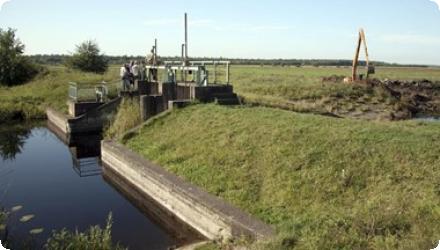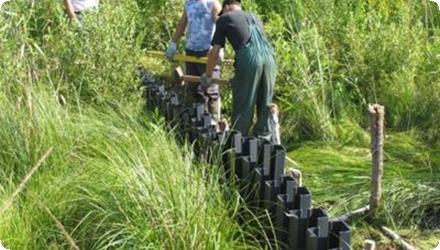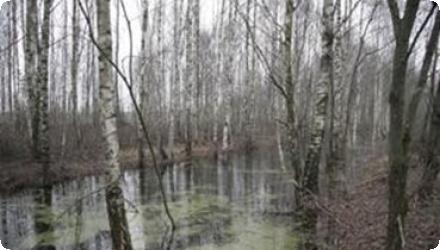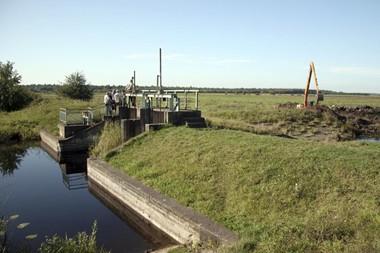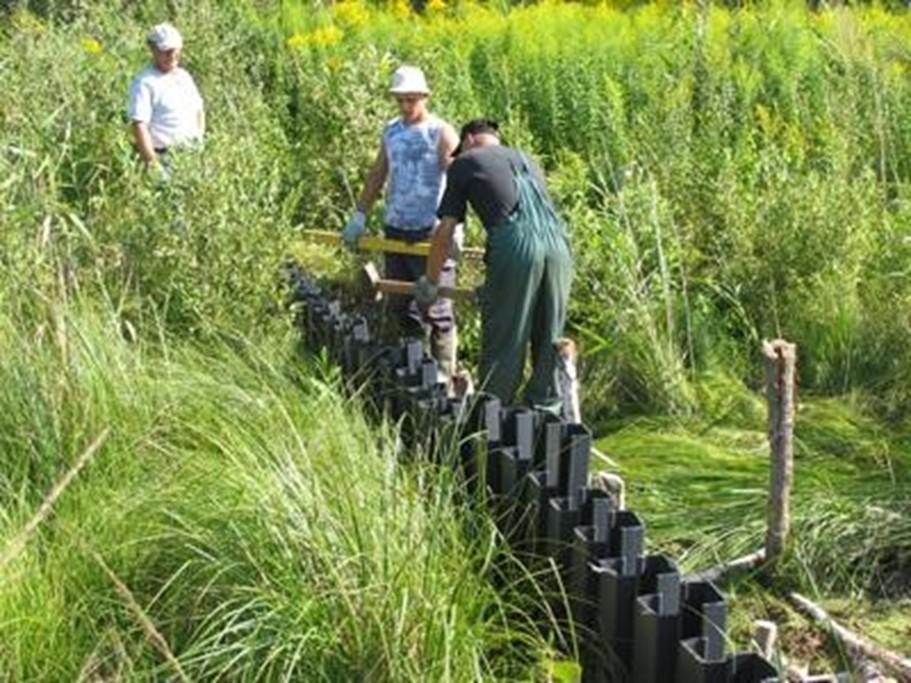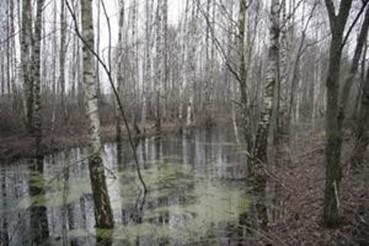Last update
2025
Summary
The WETLIFE project (2009–2012) in Amalva and Žuvintas mires sought to reverse negative changes by restoring hydrology (converting sluices to spillways, raising embankments, renovating the Amalva polder pump, blocking drainage) and by encouraging more sustainable peatland farming. It also aimed to raise awareness and provide a replicable model.
Since then, restoration has been expanded under LIFE WETLIFE 2 (2014–2018), which upgraded about 6.6 km of embankments, added spillways and a dam on the perimeter ditch, blocked underground drains and removed encroaching trees, with the goal of re-establishing “active raised bog” over ~775 ha in central and southern Amalva. Further rewetting (2019–2022, LIFE Peat Restore) targeted ~215 ha in southern Amalva with 28 retention structures across nine main ditches, four low berms with overflow crests, removal of woody growth and additional drain decommissioning.
Today the reserve operates long-term monitoring (2023–2033) of water levels and quality, while catchment management remains important due to pulsed discharges from the Simnas fishpond system that can affect Žuvintas Lake. Public access has been improved with a short boardwalk and viewing platform (2018), reinforcing outreach and stewardship.
Since then, restoration has been expanded under LIFE WETLIFE 2 (2014–2018), which upgraded about 6.6 km of embankments, added spillways and a dam on the perimeter ditch, blocked underground drains and removed encroaching trees, with the goal of re-establishing “active raised bog” over ~775 ha in central and southern Amalva. Further rewetting (2019–2022, LIFE Peat Restore) targeted ~215 ha in southern Amalva with 28 retention structures across nine main ditches, four low berms with overflow crests, removal of woody growth and additional drain decommissioning.
Today the reserve operates long-term monitoring (2023–2033) of water levels and quality, while catchment management remains important due to pulsed discharges from the Simnas fishpond system that can affect Žuvintas Lake. Public access has been improved with a short boardwalk and viewing platform (2018), reinforcing outreach and stewardship.
Position
Latitude
54.466
Longitude
23.58
Project
NWRM
National Id
Lithuania 01
Installation date
2011-2012
Implementation Status
Contact
JustÄ— BuzelytÄ—, BEF
RBD code
LT1100
Transboundary
0
Photo gallery
Location of the project
WETLIFE project is implemented in the Žuvintas biosphere reserve which is situated in the southern part of the middle Lithuanian lowlands. It comprises Žuvintas and Amalvas wetland complexes, formed in a depression of the oval limnoglacial swampy plain. Žuvintas and Amalvas lakes belong to the Dovine river catchment area (589 km2). More than half of it (345 km2) - catchment area of the Žuvintas Lake.
NUTS Code
LT00 - Latvija
Project's objectives
Reverse degradation across ~1,158 ha
Reconstruct sluice gates into spill-weirs
Extend dykes ~2 km (Amalva) and ~3 km (Žuvintas)
Renovate Amalva polder pump; block drains/plastic piling over ~207 ha in southern Amalva and ~6 km in Žuvintas
Tree removal on ~207 ha
Initiate grazing on ~30 ha in the polder.
Reconstruct sluice gates into spill-weirs
Extend dykes ~2 km (Amalva) and ~3 km (Žuvintas)
Renovate Amalva polder pump; block drains/plastic piling over ~207 ha in southern Amalva and ~6 km in Žuvintas
Tree removal on ~207 ha
Initiate grazing on ~30 ha in the polder.
Involved Partners
| Authority type | Authority name | Role | Comments |
|---|---|---|---|
Climate zone
cool temperate moist
Temperature
6 °C
Annual rainfall range
300 - 600 mm
Elevation range
85 - 131 m
Slope range
gentle (2-5%)
Vegetation class
Peat bog / mire vegetation. The case area’s dominant land cover is CORINE 412 “Peat bogs”, with communities of bog woodland (pine-dominated) and open raised-bog vegetation (Sphagnum, heather, hare’s-tail cottongrass); extensive reedbeds and sedge fens occur near Lake Žuvintas.
Water bodies: Ecological Status
Moderate
Water bodies: Chemical Status
Good
Project scale
Large
Performance timescale
1 - 4 years
Project area
1100
Design capacity description
Due to improved conditions for peat formation with the consequent CO2 accumulation in the Amalva mire and significantly reduced emissions from the Amalvas polder, total greenhouse gas emissions from degrading peat are expected to fall substantially from the currently estimated 10000 15000 t of CO2 equivalent/year.
One of the biggest challenge was finding a compromise with private owners regarding changing hydrology of the lands in their possession. Therefore reconstruction of the Amalvas winter polder into summer polder and south-eastern dike that required finding agreements with land owners and purchasing 16 private land plots is considered by the project team as a great success.
Total cost
€ 4,327,762
Costs total information
€1,603,996 Phase I LIFE WETLIFE (LIFE07 NAT/LT/000530, 2009–2012)
€1,564,386 Phase II LIFE WETLIFE 2 (LIFE13 NAT/LT/000084, 2014–2018)
€5,943,535 Overall project (5 countries) Phase III LIFE Peat Restore (LIFE15 CCM/DE/000138, 2016–2022), Lithuania component including Amalva : €1,159,380
€1,564,386 Phase II LIFE WETLIFE 2 (LIFE13 NAT/LT/000084, 2014–2018)
€5,943,535 Overall project (5 countries) Phase III LIFE Peat Restore (LIFE15 CCM/DE/000138, 2016–2022), Lithuania component including Amalva : €1,159,380
Costs investment
40863324
Costs investment information
Infrastructure, equipment and purchase of land (finale report data, page 31)
Costs land acquisition
30945,5390625
Costs land acquisition unit
€ (total value)
Costs operation maintenance
110419016
Administrative annual costs
3298272
Financing authorities
Type of funding
EU-funds: LIFE+
Comments
Total €2,670,915
Phase I LIFE WETLIFE (LIFE07 NAT/LT/000530, 2009–2012) : €801,998 (50 %)
Phase II LIFE WETLIFE 2 (LIFE13 NAT/LT/000084, 2014–2018) €1,173,289 (75 %)
Phase III LIFE Peat Restore (LIFE15 CCM/DE/000138, 2016–2022) (60%), for Lithuania €695,628
Phase I LIFE WETLIFE (LIFE07 NAT/LT/000530, 2009–2012) : €801,998 (50 %)
Phase II LIFE WETLIFE 2 (LIFE13 NAT/LT/000084, 2014–2018) €1,173,289 (75 %)
Phase III LIFE Peat Restore (LIFE15 CCM/DE/000138, 2016–2022) (60%), for Lithuania €695,628
Type of funding
National funds
Comments
Remaining balance
Compensations
0
Policy context
During second half of the 20th century Lithuania lost more than two-thirds of former mire area which covered 10% of the country. This had
the effect of causing changes in the local and regional hydrological pattern, significant loss of wildlife and peat degradation, which in turn
resulted in various secondary negative effects: CO2 emissions (approximately 25% of currently reported anthropogenic CO2 emissions, which does not take into account emissions from peatlands), water pollution due to peat mineralization products and peat subsidence. The regulation of lakes, along with increased loads of nutrients caused a rapid deterioration of water quality, siltation, and overgrowth of the lakes or even the collapse of submerged vegetation. This further led to decreased water purification capacities, as well as secondary pollution from sediments negatively affecting water bodies down the stream and, finally, the Baltic Sea arguably the most polluted sea in the world.
the effect of causing changes in the local and regional hydrological pattern, significant loss of wildlife and peat degradation, which in turn
resulted in various secondary negative effects: CO2 emissions (approximately 25% of currently reported anthropogenic CO2 emissions, which does not take into account emissions from peatlands), water pollution due to peat mineralization products and peat subsidence. The regulation of lakes, along with increased loads of nutrients caused a rapid deterioration of water quality, siltation, and overgrowth of the lakes or even the collapse of submerged vegetation. This further led to decreased water purification capacities, as well as secondary pollution from sediments negatively affecting water bodies down the stream and, finally, the Baltic Sea arguably the most polluted sea in the world.
Land ownership
16 private land plots were purchased to enable restoration; Amalva polder infrastructure and rules are administered by Marijampolė municipality.
Community involvment
No
Design consultation activity
| Activity stage | Name | Key issues | Comments |
|---|---|---|---|
|
Implementation phase
|
General project seminars
|
For project partners
|
|
|
Design phase
|
Information campaign on farming practices
|
A number of purchase negotiation meeting s with farmers, guideliness for sustainable peat grassland maangement presented to local farmers.
|
|
|
Name of policy/strategy 3
|
|||
|
Name of policy/strategy 4
|
|||
|
Name of policy/strategy 5
|
|||
|
Name of policy/strategy 6
|
Policy target
| Target purpose |
|---|
|
Improved Biodiversity
|
|
Runoff control
|
|
Pollutants Removal
|
Target Remarks
Regulation of hydrological cycle and water flow
Self-regulation of water by filtration / storage / accumulation by ecosystems
To achieve favourable conservation status of bog and swamp wood habitats
Self-regulation of water by filtration / storage / accumulation by ecosystems
To achieve favourable conservation status of bog and swamp wood habitats
Policy pressure
| Pressure directive | Relevant pressure |
|---|---|
|
WFD identified pressure
|
4.1.2 Physical alteration of channel/bed/riparian area/shore of water body for agriculture
|
|
Other EU
|
Hydrological regime alterations impacting bog and swamp wood habitats
|
Policy impact
| Impact directive | Relevant impact |
|---|---|
|
WFD identified impact
|
4.1.2 Physical alteration of channel/bed/riparian area/shore of water body for agriculture
|
Requirement directive
| Requirement directive | Specification |
|---|---|
|
WFD-mitigation of significant pressure
|
Water Framework Directive
|
|
WFD-achievement of good ecological status
|
|
|
WFD-achieving objectives for Protected areas
|
|
|
The Birds and Habitat Directives
|
Contractual arrangements
0
| Arrangement type | Responsibility | Role | Name | Comments |
|---|---|---|---|---|
|
Contractual agreement
|
Amalvas wetland drainage blocking project, Amalvas wetland water level re-naturalization activity
|
Hydrologist-engineer
|
||
|
Contractual agreement
|
Purchase of 25 ha land
|
JSC Agrogeodezija
|
||
|
Contractual agreement
|
Restoration of the drained southern part of the Amalvas wetland
|
JSC Alytaus melioracija
|
||
|
Contractual agreement
|
Reconstruction of Amalvas polder
|
JSC Sumeda, etc.
|
Part of wider plan
0
Wider plan type
| Wider plan type | Wider plan focus | Name | Comments |
|---|---|---|---|
|
Regional
|
Water
|
||
|
Regional
|
Environment & Biodiversity
|
||
|
Regional
|
Climate adaptation
|
||
|
Local
|
Agriculture
|
1. Landscape, biodiversity monitoring
2. Žuvintas lake hydrological monitoring, daily
3. Meteorological monitoring, daily
4. Bambena and Dovine river flow monitoring, every 5 days
5. Amalvas hydrological and hydrochemical monitoring, every 10 days
2. Žuvintas lake hydrological monitoring, daily
3. Meteorological monitoring, daily
4. Bambena and Dovine river flow monitoring, every 5 days
5. Amalvas hydrological and hydrochemical monitoring, every 10 days
Maintenance
The reconstruction of the Žuvintas and Amalvas sluice-gates into permanent spillweirs, along with a reduction in the length of Amalvas protective dike by 0.8 km and blocked ditches in 250 ha has simplified maintenance and reduce costs.
Edge of Field/Plot
• The foreseen water pumping regime in the Amalvas polder, new pumps and reduced seepage through the dikes should significantly reduce annual electricity bills covered by Marijampolė municipality.
• Less than 60% of the polder area was used last year and bushes spread in the abandoned land. Some areas by contrast went under the plough increasing peat mineralization and subsidence. It is expected that after reconstruction of the polder most of the land will be maintained as grasslands because substantial areas will correspond to the criteria of land where management can be supported by higher agrienvironmental payments. This, in turn, is expected to facilitate development of alternative uses of grasslands, such as the production of grass seeds, grass biomass for alternative fuel etc.
• The introduced herd of beef cattle (16 units) in the Amalvas polder on a contract basis with the local farmer should increase in years to come, thereby maintaining 40- 70 ha of grazed wet meadows by 2016 and serve as an additional income source for the local farmer. It is expected to serve as a good example and involve more farmers in similar cooperation in the future.
• The reconstruction of the Žuvintas and Amalvas sluice-gates into permanent spillweirs, along with a reduction in the length of Amalvas protective dike by 0.8 km and blocked ditches in 250 ha will simplify maintenance and reduce costs.
• The revival of Amalva bog should significantly increase the amount of cranberries ready to be harvested by local people.
Agri-nature interface: meadow restoration (6 ha), advice for ~40 ha, adjustments to melioration to protect ~30 ha, 16 beef cattle provided to a local farmer to maintain wet peat meadows. 14 stakeholder events on mire services.
• Less than 60% of the polder area was used last year and bushes spread in the abandoned land. Some areas by contrast went under the plough increasing peat mineralization and subsidence. It is expected that after reconstruction of the polder most of the land will be maintained as grasslands because substantial areas will correspond to the criteria of land where management can be supported by higher agrienvironmental payments. This, in turn, is expected to facilitate development of alternative uses of grasslands, such as the production of grass seeds, grass biomass for alternative fuel etc.
• The introduced herd of beef cattle (16 units) in the Amalvas polder on a contract basis with the local farmer should increase in years to come, thereby maintaining 40- 70 ha of grazed wet meadows by 2016 and serve as an additional income source for the local farmer. It is expected to serve as a good example and involve more farmers in similar cooperation in the future.
• The reconstruction of the Žuvintas and Amalvas sluice-gates into permanent spillweirs, along with a reduction in the length of Amalvas protective dike by 0.8 km and blocked ditches in 250 ha will simplify maintenance and reduce costs.
• The revival of Amalva bog should significantly increase the amount of cranberries ready to be harvested by local people.
Agri-nature interface: meadow restoration (6 ha), advice for ~40 ha, adjustments to melioration to protect ~30 ha, 16 beef cattle provided to a local farmer to maintain wet peat meadows. 14 stakeholder events on mire services.
Information on retained water
Phase I outcomes: water level restored to 0.0–0.3 m below surface across ~210 ha; seasonal natural water levels over ~638 ha of polder; water-level management rules set for 30–60 cm during farming season. Mire's dryness decreased, ground water level stabilized.
Second phase (LIFE WETLIFE 2, 2014–2018) at Amalva: 6.6 km of dykes raised/restored/new; two spillways + a dam on the perimeter ditch; >20 ha underground drains blocked; ~140 ha tree removal. Target: regeneration of “active raised bog” on ~775 ha in central/southern Amalva.
2019–2020 piezometers show the water table below ground most of the time (e.g., AMAL02: >99% of days below; AMAL03/04 above ground 35–42%), confirming the need for rewetting.
Third phase (LIFE Peat Restore, 2019–2022) in south Amalva (~215 ha): 28 peat/ plastic-sheet piling dams across nine main ditches; four peripheral berms with overflow wells; woody vegetation removal; subsurface drains dismantled.
Second phase (LIFE WETLIFE 2, 2014–2018) at Amalva: 6.6 km of dykes raised/restored/new; two spillways + a dam on the perimeter ditch; >20 ha underground drains blocked; ~140 ha tree removal. Target: regeneration of “active raised bog” on ~775 ha in central/southern Amalva.
2019–2020 piezometers show the water table below ground most of the time (e.g., AMAL02: >99% of days below; AMAL03/04 above ground 35–42%), confirming the need for rewetting.
Third phase (LIFE Peat Restore, 2019–2022) in south Amalva (~215 ha): 28 peat/ plastic-sheet piling dams across nine main ditches; four peripheral berms with overflow wells; woody vegetation removal; subsurface drains dismantled.
Information on Water quality overall improvements
Restoring of natural water level fluctuations in Ž’uvintas and Amalvas has enabled these lakes to more easily purify its waters.
1
Amalvas sustainable polder water pumping mode installed to ensure migratory birds population increase. Restore the natural water level fluctuations in Lake Ž’uvintas should lead to water vegetation recovery, some fish and amphibian species spawning areas expand, and stop the spread reeds and thickets. Reconstruction and Ž’uvintas Amalvas locks-regulator installation passes, allowing fish to migrate.
Information on Ecosystem impact GHG soil carbon
Total greenhouse gas emissions from degrading peat are expected to fall substantially from the currently estimated 10000 15000 t of CO2 equivalent/year.
Amalva south, ~215 ha : GEST-based estimate that emissions dropped from ~5,800 to ~800 t CO₂-eq/yr once rewetting and bog vegetation re-establish; reserve and state-forest services tasked with ongoing maintenance/monitoring.
Amalva south, ~215 ha : GEST-based estimate that emissions dropped from ~5,800 to ~800 t CO₂-eq/yr once rewetting and bog vegetation re-establish; reserve and state-forest services tasked with ongoing maintenance/monitoring.
Key lessons
Hydrology-first, multi-wave restoration is often required; Phase I created gains, Phase II expanded water-retention capacity, Phase III targeted the most drained sector.
Woody removal + ditch blocking work, but methods must adapt to site condition; at Amalva, repeated cutting failed in compacted/nutrient-rich patches and was replaced by herbicide.
Coupling with farming is key: explicit polder water-rules and grazing contracts reduced conflicts and sustained wet meadow management.
Design for safety: perimeter structures with overflow wells manage high-water events while keeping the bog wet.
Monitor for the long haul: piezometers + a formal 2023–2033 programme are essential to demonstrate outcomes and steer adaptive management.
Think catchment: external loads/abstractions (fishponds, drought) can undermine on-site gains; governance beyond site boundaries matters.
The project made an important push in promoting agi-environmental measures in the area. There is a common understanding achieved among decision makers regarding further land use on drained peatlands. However despite of significantly increased local awareness of environmental hazards related to unsustainable management of organic peat soils, there is a great need for national and European policies regarding this issue. Abandonment of subsidies for damaging farming on organic soils would prove to be extremely beneficial for biodiversity conservation and minimizing other negative environmental consequences.
Woody removal + ditch blocking work, but methods must adapt to site condition; at Amalva, repeated cutting failed in compacted/nutrient-rich patches and was replaced by herbicide.
Coupling with farming is key: explicit polder water-rules and grazing contracts reduced conflicts and sustained wet meadow management.
Design for safety: perimeter structures with overflow wells manage high-water events while keeping the bog wet.
Monitor for the long haul: piezometers + a formal 2023–2033 programme are essential to demonstrate outcomes and steer adaptive management.
Think catchment: external loads/abstractions (fishponds, drought) can undermine on-site gains; governance beyond site boundaries matters.
The project made an important push in promoting agi-environmental measures in the area. There is a common understanding achieved among decision makers regarding further land use on drained peatlands. However despite of significantly increased local awareness of environmental hazards related to unsustainable management of organic peat soils, there is a great need for national and European policies regarding this issue. Abandonment of subsidies for damaging farming on organic soils would prove to be extremely beneficial for biodiversity conservation and minimizing other negative environmental consequences.
Success factor(s)
| Success factor type | Success factor role | Comments | Order |
|---|---|---|---|
|
Successful coordination between authorities
|
main factor
|
The project served as a good basis for establishing cooperation among protected area administration, municipality, environmental non-governmental organisation and local residents. |
2
|
Driver
| Driver type | Driver role | Comments | Order |
|---|---|---|---|
|
Legal obligations
|
main driver
|
To ensure conservation status of the area
|
1
|
|
Organisation committed to it
|
main driver
|
Nature Heritage Fund is a leading organisation in country to protect and maintain species of the comunity's interest (SCI)
|
2
|
|
Availability of subsidies
|
secondary driver
|
LIFE Nature programme is supporting the biodiversity restoration projects
|
3
|
Transferability
water level and provides exceptional longevity comparing to other materials; It was the first project in the country that purchased land for mire restoration. This served as an important signal to other nature conservationists and land owners as well. There are already several initiatives in the country following the same road.
Cost effectiveness
1st project in the country that used plastic pilling dams for hydrology restoration on a big scale. It’s cost-effective method as using this material allows much faster restoration of water level and provides exceptional longevity.
English
